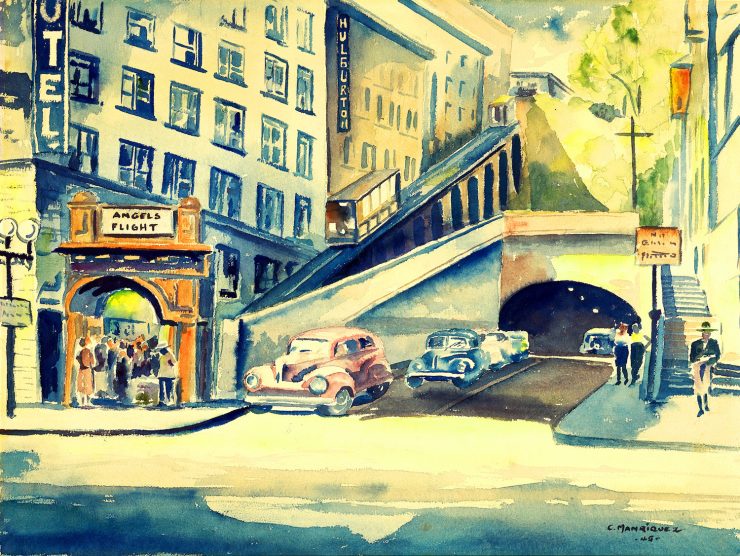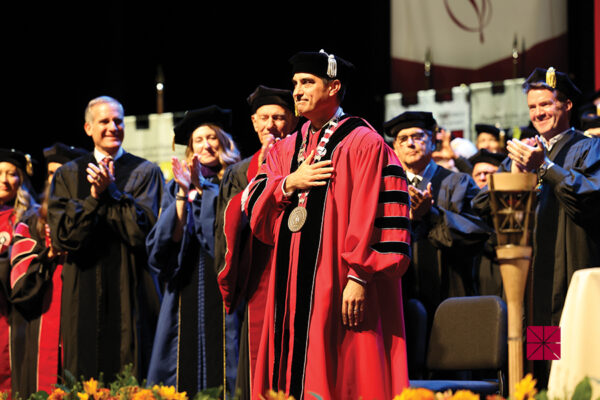Chapman University’s Hilbert Museum of California Art has acquired a 1930s-era watercolor painting by an early Disney artist, Carlos Manriquez. The purchase is the six-year-old museum’s first through its acquisition fund, supported by patron donations.
“When we heard that this painting had become available through a collector, we knew we had to acquire it,” said Mary Platt, director of the Hilbert Museum. “Not only is it a wonderful example of California Scene painting – a genre of watercolors and oils depicting everyday life in the Golden State – but it’s also an example of a work by a Latinx artist who worked at Walt Disney Studio in its early years, possibly Disney’s first Latinx artist.
“We believe Carlos Manriquez’s name and talent deserve wider recognition. Because our museum is unique in showing both the fine art and animation art of creators who worked for Hollywood’s movie studios, there’s no better home for this work, for posterity,” says Platt.
A Chance Encounter Leads to a Historic Animation Career
Carlos Daniel Manriquez was born in Mexico on April 10, 1908, and would eventually move to Los Angeles. His family’s lore recounts that 20-year-old Manriquez was sitting in a park one day, doodling some sketches, when he became aware of a man watching him drawing. Manriquez had just finished up and was packing his pencils and sketchpad when the man asked him if he wanted a job.
The man was Walt Disney – and soon thereafter, Manriquez joined the Walt Disney Studio as its first full-time background painter. He was by most accounts also the first artist of Mexican descent at Disney, beginning work there in 1929 and leaving the studio in 1938.
The Disney background department eventually expanded to include Emil Flohri, and remained a two-man enterprise until 1931, when a third artist, Mique Nelson, joined the team. They were responsible for creating the scenic backgrounds upon which hand-painted cels were placed and photographed. Their projects included Disney’s popular “Silly Symphonies” series of animated shorts, as well as many of the studio’s Mickey Mouse shorts.
While he worked in the animation industry, like many other Los Angeles artists, Manriquez painted everyday life around him in his spare time – a Regionalist style that would later come to be known as the “California Scene” genre.
After leaving Disney, Manriquez worked for Warner Bros animation, where he continued to paint backgrounds for cartoon shorts. He later moved to Mexico City, where he worked on “Rocky and Bullwinkle” at Val-Mar Productions. Manriquez later started his own studio in Mexico. He passed away on May 1,1981, at age 73.
Angels Flight: A Favorite Los Angeles Landmark
The Manriquez painting acquired by the Hilbert Museum is a watercolor depicting Angels Flight, downtown L.A.’s famous narrow-gauge funicular that opened in 1901 and still ferries passengers up and down Bunker Hill. The painting is undated but probably was created in the early 1930s, while Manriquez was working at Disney – but painted during his own personal time (many California Scene painters worked at the motion-picture studios to make a living, and painted scenes of California life on their own time, on weekends and holidays).
The hillside railway, still a tourist attraction today, was a popular subject for many well-known California Scene painters, including Ralph Hulett and Ben Abril. Manriquez gives the scene a whimsical touch and portrays Angel’s Flight as it was in the ‘30s, in its original location next to the Third Street tunnel. The funicular was later moved and opened in its current location, across from the Grand Central Market, in 1996.
The newly acquired painting is currently being catalogued into the Hilbert Museum permanent collection and will go on public display at a later date.
To stay up to date with new acquisitions and exhibits, follow the Hilbert Museum on Facebook and Instagram.




